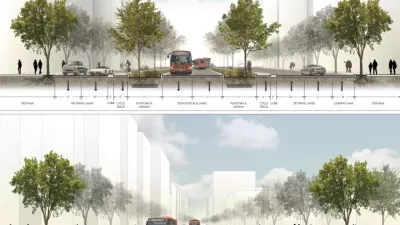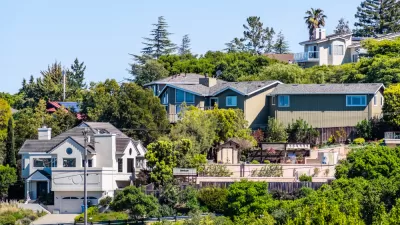Architects and planners have to work together, as everyone on both sides of the equation knows. Even though the fields often speak the same language, there still seem to be many moments and ideas lost in translation.

"Local architects love to complain about San Francisco’s Planning Department, how the latter supposedly thwarts the formers’ efforts to add dynamic new buildings to the landscape," writes John King, in news that won't come as surprise to Planetizen readers.
The reason the San Francisco Chronicle's urban design critic is writing about the history of antipathy between the two related professional fields, however, is that one of San Francisco's best designers has gone on the record with a fairly disparging diatribe regarding planning and planners in a new book by Michael Webb, titled Building Community: New Apartment Architecture .
In the book, Stanley Saitowitz tells Webb of his frustrations as an architect with city planners: "Far too much of our effort goes into explaining what we are doing….The bureaucracy is obstructive, and committee-type negotiations tend to make the buildings worse, not better."
More of Saitowitz's comments are included in the article, especially focusing on tensions between contemporary design decisions and a preservationist approach to new building (those tensions will surely be familiar in cities other than San Francisco).
The comments have provoked a notable response from San Francisco's planning director, John Rahaim, who says: "Most of Stanley’s buildings have been built pretty much as he proposed them to staff. To say otherwise is ridiculous."
Rahaim also has more to say, but King also has the final word about whether these kinds of debates will ever end in San Francisco (spoiler alert: it's not likely).
FULL STORY: Architect calls SF planners “obstructive.” Spoiler alert: they’re ticked

Planetizen Federal Action Tracker
A weekly monitor of how Trump’s orders and actions are impacting planners and planning in America.

Maui's Vacation Rental Debate Turns Ugly
Verbal attacks, misinformation campaigns and fistfights plague a high-stakes debate to convert thousands of vacation rentals into long-term housing.

Restaurant Patios Were a Pandemic Win — Why Were They so Hard to Keep?
Social distancing requirements and changes in travel patterns prompted cities to pilot new uses for street and sidewalk space. Then it got complicated.

In California Battle of Housing vs. Environment, Housing Just Won
A new state law significantly limits the power of CEQA, an environmental review law that served as a powerful tool for blocking new development.

Boulder Eliminates Parking Minimums Citywide
Officials estimate the cost of building a single underground parking space at up to $100,000.

Orange County, Florida Adopts Largest US “Sprawl Repair” Code
The ‘Orange Code’ seeks to rectify decades of sprawl-inducing, car-oriented development.
Urban Design for Planners 1: Software Tools
This six-course series explores essential urban design concepts using open source software and equips planners with the tools they need to participate fully in the urban design process.
Planning for Universal Design
Learn the tools for implementing Universal Design in planning regulations.
Heyer Gruel & Associates PA
JM Goldson LLC
Custer County Colorado
City of Camden Redevelopment Agency
City of Astoria
Transportation Research & Education Center (TREC) at Portland State University
Jefferson Parish Government
Camden Redevelopment Agency
City of Claremont





























